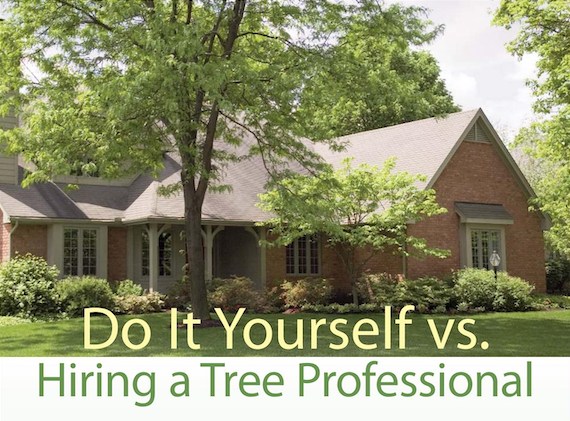Do It Yourself vs. Hiring a Tree Professional

You are in your yard one day and you notice several large branches growing from one of your shade trees over the patio.
The job looks like quick work. Just get a ladder and a chain saw, climb up into the tree, make the cut and it’s a quick job made easy.
Sure, there are a couple of electric wires close by, but they don’t seem to be in the way.
Hold Everything!
Most do-it-yourselfers have no business trying to do work of this nature. By pruning your own trees, you may be putting yourself in a dangerous position. There are too many risks and dozens of ways for this scene to turn ugly.
Dangers of DIY Tree Work
Most do-it-yourselfers shouldn’t even think about operating a chain saw from a ladder or over their heads. They also shouldn’t be using ladders anywhere near power lines, and they certainly shouldn’t try to climb the tree without proper training and tree climbing equipment.
The power lines that run from pole to pole carry high-voltage electricity. Each year, a number of amateur tree pruners are seriously injured or killed when they come into contact with an energized line, directly or indirectly through tools or tree limbs.
Even without the power wires, ladders and tree climbing, lack of training and the wrong cut could easily cause a large branch to fall on the house, passersby, or even the do-it-yourselfer.
Pruning trees without proper training or equipment is asking for trouble. Not only for the immediate safety issues, but untrained do-it-yourselfers can unknowingly mutilate a tree. This will leave it open to disease that could kill it or weaken it and cause dangerous hazards later on.
Hire a professional for any large tree work that requires climbing. The techniques demanded of arborists take years to develop. The practiced techniques prevent many accidents every day.
What Can I Do With My Own Trees?
- Work on trees and shrubs that do not require your feet to leave the ground. Prune out dead and broken branches within reach of a handsaw, pole saw, or pole pruner.
- Be very cautious when pruning branches directly overhead. They can sometimes tear or fall unexpectedly during pruning.
- Apply a generous layer of wood chips or mulch to the root zone. This will help retain moisture and provide beneficial organic material to the tree roots.
- Have your trees inspected regularly for disease or decay to prevent hazards.
Even on smaller diameter trees, if you have to climb a ladder to prune them you are putting yourself at risk. The right training and the right equipment come standard with most tree care companies, especially accredited companies that have certified arborists and certified tree safety professionals on their staff.
Reasons You Might Do the Work Yourself
- It is cheaper than hiring someone.
- The amount of work is minor and easily accomplished with typical home equipment.
- You can easily reach the branches without climbing a ladder or rope.
- You are a professional tree care worker.
Reasons to Hire a Qualified Professional
- They have years of experience and training.
- They can provide in-depth evaluations for hidden damage.
- Risk and liability are placed on the professional.
- Work can be done safely and efficiently using the proper equipment.
- Opportunity for long-term tree care from a professional familiar with your trees.
Minimum Qualifications to Look For
- Make certain the company has a current insurance card. Ask to see a copy.
- Ask for a list of references.
- They should provide a written proposal of work with specific cost estimate details.
- List of recent training programs and memberships in associations, such as the Tree Care Industry Association (TCIA) or International Society of Arboriculture (ISA).